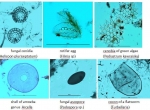Non-pollen palynomorphs
Non-pollen palynomorphs – NPPs – are microfossils of plants (other than pollen), algae included, animals, fungi and cyanobacteria (fig. 1.). NPPs are determined and counted on palynology slides parallel with pollen grains. Mass occurrence of some species and taxa of higher order, including rare taxa, as well as analysis of the co-occurrence of forms regarded as bioindicators, is an important element in the reconstruction of palaeoenvironments. For example, mass occurrence of spores of coprophilous fungi (e.g., Podospora, Spromiella) indicates the presence of faeces of herbivorous animals and, if the context is right, may confirm cattle herding in a site. Spores of another fungus (Neurospora) indicate the presence of burnt ground and those of Glomus are associated with soil erosion. The presence in peat of shells of genus Amphitrema indicates oligotrophic conditions and high water levels. An important index group are green algae from genus Pediastrum. A great variety of their species survive in the fossil record. Individual species are indicators of water level fluctuation, trophic levels, pH and temperature.
ML, JŚM, AP, MZ
Literature:
B. Van Geel, Application of fungal and algal remains and other microfossils in palynological analyses, [in:] B. E. Berglund, (ed.), Handbook of Holocene Paleoecology and Paleohydrology, New York 1986, p. 497-505; V. Jankowská, J. Komárek, Indicative value of Pediastrum and other coccal green algae in palaeo-ecology, Folia Geobotanica 35, 2000, p. 59-82; B. Van Geel, Non-pollen palynomorphs, [in:] John P. Smol, H. J. B. Birks, W. M. Last, (eds.), Tracking Environmental Change Using Lake sediments, t. 3, Terrestial algal and siliceous indicators, Dordrecht, Boston London 2001, p. 99-119; M. Latałowa, Mikrofosylia pozapyłkowe w osadach dennych Zalewu Szczecińskiego, Prace Komisji Paleogeografii Czwartorzędu PAU, 1, 2003, p. 125-128; B. Van Geel, Preface. Quaternary non-pollen palynomorphs’ deserve our attention! Review of Palaeobotany and Palynology, 141, 2006, pp. 1-2.
-
 full resolution
full resolution
Fig. 1. Non-pollen microfossils viewed under a optical microscope at magnification of 400x. Photo A. Pedziszewska , M. Zimny and J. Święta-Musznicka.


